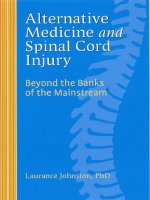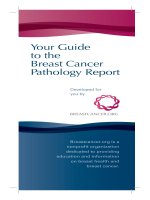Knee injury pathology
Bạn đang xem bản rút gọn của tài liệu. Xem và tải ngay bản đầy đủ của tài liệu tại đây (2.74 MB, 67 trang )
Knee Injury Pathology
T. Ross Bailey, M.Ed., ATC
Joe Milne, M.D.
Pathology
Intra Articular Pathology
Pathology that occurs within the joint capsule
Extra Articular Pathology
Pathology that occurs outside the joint capsule
Pathology
Extra Articular Soft Tissue Pathology
Bursitis- the fluid sacks called bursae in body are designed for
friction control. Bursitis is usually associated with other injuries
or overuse problems.
Prepatellar bursitis- sx: swelling on top of the knee cap due to
direct trauma.
Suprapatellar bursitis- sx: generalized swelling of the knee
above and behind the patella. Suprapatellar bursitis is a common
complication after knee surgery or trauma.
Infrapatellar tendon bursitis- sx: pain with complete passive
flexion and pain with complete active extension due to pressure
on the bursae. There are two portions of the bursae; one distal to
patella and above tendon, one distal but behind the tendon.
Cause is generally overuse.
Pes Anserine bursitis - sx: pain under the medial and distal
insertion of the gracilis, semitendinosus, and sartorius. Resistive
mm test to the above mm may cause irritation.
Lateral bursitis- sx: pain proximal to head of fibula caused by
frictional forces between LCL (lateral collateral ligament) and
other structures. It is difficult to differentiate from other problems.
Popliteal bursitis- sx: pain between the LCL and the popliteus
tendon which is difficult to differentiate from popliteal tendinitis.
Screw home mechanism must be examined with this problem.
Bursae Symptoms
Localized Inflammation
Warm to touch
Extra articular swelling
Tendinitis
Can occur at any musculotendinous or osteo tendonous junction of
the knee and is usually associated with overuse or microtrauma.
Good basic anatomy and palpation skills are necessary to determine
the structures involved. Isolated mm test also pin point the tendon
involved.
Patellar tendinitis- sx: pain and swelling directly over the
infrapatellar part of the tendon and the insertion of the tendon into the
tuberosity. The injury is common in jumping athletes who stress the
tendon with position and forceful quad contractions. "jumper's knee"
This condition is very often associated with tight hamstrings. The
harder the extension mechanism of the knee has to work, the the
pressures on patellar tendon increase and as a result of the over use,
tendinitis results. Always have patients stretch their hamstrings.
Popliteus tendinitis- sx: pain in posterior-lateral aspect of knee with
increased pain on terminal knee extension and foot internal rotation.
Overuse causes include forced rotation of the knee and down hill
running.
Pes Anserine tendinitis- sx: pain distal and medial on the knee at the
tendinous insertion of gracilis, sartorius, and semitendinosus.
Iliotibial band tendinitis - sx: diffuse pain and tenderness on
the lateral side of the knee usually where the it band rubs over the
lateral epicondyle. Associated signs are a cross over running style,
strong adductors and tight and/or weak it bands. "runner's knee“
Hamstring tendinitis - sx: pain and tenderness over the
insertions of any of the three heads of the hamstring. Crepitus and
swelling can be felt with deep palpation of the tendons and mm tests
are painful.
Gastroc tendinitis - sx: pain in the posterior aspect of the knee
associated with either head of the muscle. Remember to control ankle
movement when isolating the pain.
Baker's cyst
sx: dull aching pain and full feeling behind the knee
due to an inflammation of semimembranosus
tendon or the medial gastrocnemius bursae. In more
advanced stages there is a palpable lump in the
popliteal fossa, sometimes due to the herniation of
a tendon sheathe. A Baker's cyst is often indicative
of underlying pathology such as an old meniscal
lesion.
Patella and Patellar Tracking
Problems
Chondromalacia
sx: pain underneath the patella with possible
popping or crepitus especially in the 60-90 degree
ROM. Direct pressure may elicit the pain; lateral
patellar play, stairs and prolonged sitting are also
problems. Causes include large Q angles, laterally
riding or subluxating patella's, overuse, and mm
imbalance.
Subluxating patella
sx: giving way sensation, popping, local tenderness and a
positive apprehension test. Causes include contraction of
quad with a medial blow or externally rotated foot, small
lateral condyle, tight lateral retinaculum.
Dislocating patella
sx: if the patella is out, the knee is severely
deformed, painful, flexed, and patella is normally
on the lateral side of the knee. Causes are the same
as above.
Fractured patella
Limited ROM and localized edema
Notes
Research shows that approximately 50% of patients with
patellar fractures have some limitation of function following
the fracture healing and or surgical repair.
Research shows that less than 1% of bone – tendon – bone
ACL autograph patients have patellar fractures following
surgery
Bony Problems in the Knee
Osteochondritis dissecans- sx: generalized and
nonspecific pain and discomfort after activity,
intermittent swelling, giving way and instability.
The pain is due to a slight excavation of bone on
the articular surface secondary to trauma and
compromised blood supply. Special test include xrays and Wilson's test where foot is internally
rotated and knee is extended the last 30 degrees
under valgus stress.
OCD – Medial Femoral Condyle
OCD – Medial Femoral Condyle









